If a skater of weight 3 kg has initial speed 32 m/s and second one of weight 4 kg has 5 m/s. After collision, they have speed (couple) 5 m/s. Then the loss in K.E. is
(1) 48 J
(2) 96 J
(3) Zero
(4) None of these
यदि 3 kg भार के एक स्केटर की प्रारंभिक चाल 32 m/s है और 4 kg भार के दूसरे स्केटर की चाल 5 m/s है। संघट्ट के बाद, उनकी चाल (सयुंक्त) 5m/s है। तब गतिज ऊर्जा में ह्रास है:
(1) 48 J
(2) 96 J
(3) शून्य
(4) इनमें से कोई नहीं
A small mass attached to a string rotates on a frictionless table top as shown. If the tension on the string is increased by pulling the string causing the radius of the circular motion to decrease by a factor of 2, the kinetic energy of the mass will
1. Increase by a factor of 4
2. Decrease by a factor of 2
3. Remain constant
4. Increase by a factor of 2
जैसा कि दर्शाया गया है एक छोटे पिंड से जुड़ा हुआ एक धागा एक घर्षण रहित मेज की सतह पर घूमता है। यदि धागे को खींचते हुए धागे पर तनाव को बढ़ाया जाता है जिससे वृत्तीय गति की त्रिज्या 2 के गुणक से कम हो जाती है, तो पिंड की गतिज ऊर्जा हो जाती है:
(1) 4 के गुणक से बढ़ती है
(2) 2 के गुणक से घटती है
(3) नियत रहती है
(4) 2 के गुणक से बढ़ती है
The moment of inertia of a thin rectangular plate ABCD of uniform thickness about an axis passing through the centre O and perpendicular to the plane of the plate is
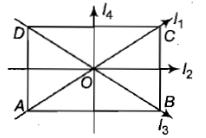
1.
2.
3.
4.
एक समान मोटाई की एक पतली आयताकार प्लेट ABCD है, केंद्र O से गुजरने वाले और प्लेट के तल के लंबवत अक्ष के परितः उसका जड़त्व आघूर्ण है:
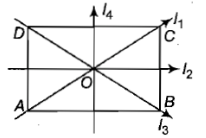
1.
2.
3.
4.
A solid cylinder and a solid sphere both having the same mass and radius, are released from a rough inclined plane. Both roll without slipping. Then,
1. the force of friction that acts on the two is the same
2. the force of friction is greater in case of a sphere than for a cylinder
3. the force of friction is greater in case of a cylinder than for a sphere
4. the force of friction will depend on the nature of the surface of the body that is moving and that of the inclined surface and is independent of the shape and size of the moving body
एक ठोस बेलन और एक ठोस गोला दोनों समान द्रव्यमान और त्रिज्या वाले हैं, जो दृढ आनत तल से छोड़े जाते हैं। दोनों बिना फिसले लुढ़कते हैं। तब,
1. घर्षण बल जो दोनों पर कार्य करता है समान है
2. बेलन की तुलना में गोले की स्थिति में घर्षण बल अधिक है
3. गोले की तुलना में बेलन की स्थिति में घर्षण बल अधिक है
4. घर्षण बल, गतिमान पिंड और आनत सतह की सतह की प्रकृति पर निर्भर करेगा और गतिमान पिंड के आकार और माप से स्वतंत्र होगा
A ball of mass m moving with velocity collides a wall as shown in the figure. After impact, it rebounds with a velocity . The impulse acting on ball during impact is
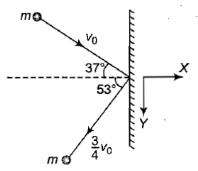
1.
2.
3.
4. None of these
जैसा कि आरेख में दिखाया गया है m द्रव्यमान की एक गेंद वेग से गति करते हुए एक दीवार से संघट्ट करती है। प्रभाव के बाद, यह वेग से वापस लौटती है। प्रभाव के दौरान गेंद पर कार्य करने वाला आवेग है
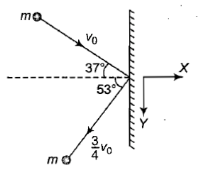
1.
2.
3.
4. इनमें से कोई नहीं
A shell initially at rest explodes into two pieces of equal mass, then the two pieces will
(1) Be at rest
(2) Move with different velocities in different directions
(3) Move with the same velocity in opposite directions
(4) Move with the same velocity in same direction
प्रारम्भ में विरामावस्था में एक कोश समान द्रव्यमान के दो टुकड़ों में टूट जाता है, तब दोनो टुकड़े होंगे:
(1) विरामावस्था में होंगे
(2) विभिन्न दिशाओं में अलग-अलग वेगों के साथ गति करेंगे
(3) विपरीत दिशाओं में समान वेग से गति करेंगे
(4) समान दिशा में समान वेग से गति करेंगे
Three indentical spheres, each of mass 1 kg are kept as shown in figure, touching each other, with their centres on a straight line. If their centres are marked P, Q, R respectively, the distance of centre of mass of the system from P is
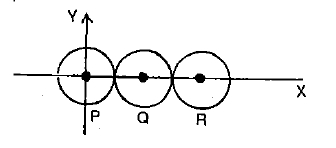
जैसा कि आकृति में दर्शाया गया है प्रत्येक 1 kg द्रव्यमान के तीन एकसमान गोले एक सरल रेखा पर अपने केंद्रों के साथ एक दूसरे को स्पर्श करते हुए रखे गए हैं। यदि उनके केंद्रों को क्रमशः P, Q, R के रूप में अंकित किया गया है, तब P से निकाय के द्रव्यमान केंद्र की दूरी है:

From a uniform square plate of side a and mass m, a square portion DEFG of side is removed. Then, the moment of inertia of the remaining portion about the axis AB is
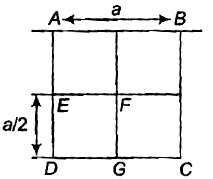
1. \(\dfrac{7ma^2}{16}\)
2. \(\dfrac{3ma^2}{16}\)
3. \(\dfrac{3ma^2}{4}\)
4. \(\dfrac{9ma^2}{16}\)
a भुजा और m द्रव्यमान की एकसमान वर्गाकार प्लेट से, भुजा के एक वर्गाकार भाग DEFG को निकाला जाता है। तब, अक्ष AB के परितः शेष भाग का जड़त्व आघूर्ण ज्ञात कीजिए।
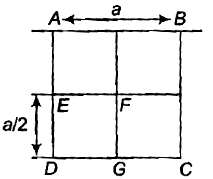
1. \(\dfrac{7ma^2}{16}\)
2. \(\dfrac{3ma^2}{16}\)
3. \(\dfrac{3ma^2}{4}\)
4. \(\dfrac{9ma^2}{16}\)
A solid sphere is rotating in free space. If the radius of the sphere is increased keeping mass same which one of the following will not be affected
1. Moment of inertia
2. Angular momentum
3. Angular velocity
4. Rotational kinetic energy
एक ठोस गोला मुक्त स्थान में घूम रहा है। यदि गोले की त्रिज्या द्रव्यमान को समान रखते हुए बढ़ाई जाती है, जो निम्न में से किसी एक पर प्रभाव नहीं डालेगी
(1) जड़त्व आघूर्ण
(2) कोणीय संवेग
(3) कोणीय वेग
(4) घूर्णन गतिज ऊर्जा
The magnitude of the impulse developed by a mass of 0.2 kg which changes its velocity from is
1. 2.7 N-s
2. 1.8 N-s
3. 0.9 N-s
4. 3.6 N-s
0.2 kg के द्रव्यमान से विकसित आवेग का परिमाण जो इसके वेग को परिवर्तित करता है, है:
1. 2.7 N-s
2. 1.8 N-s
3. 0.9 N-s
4. 3.6 N-s








